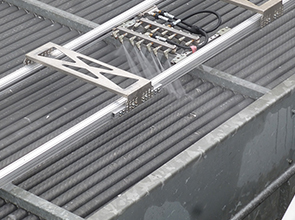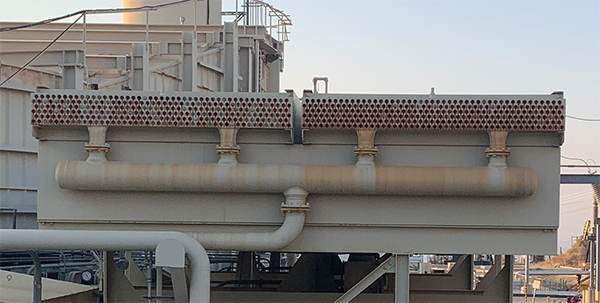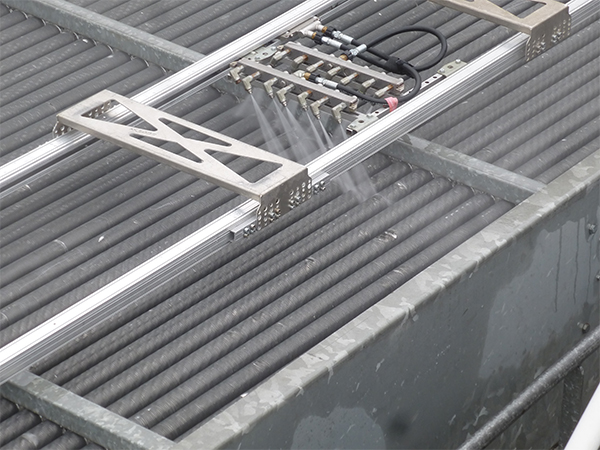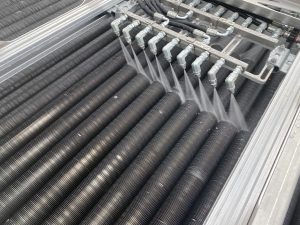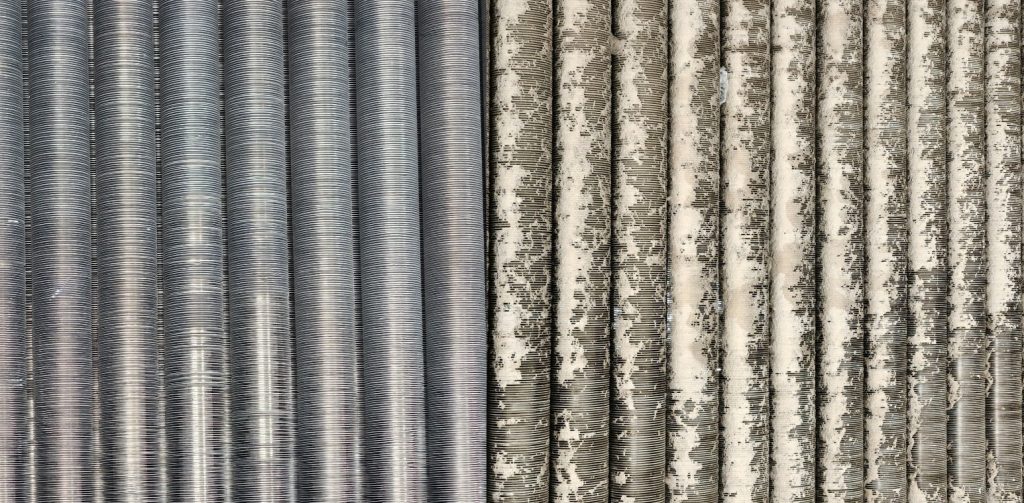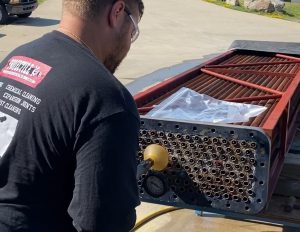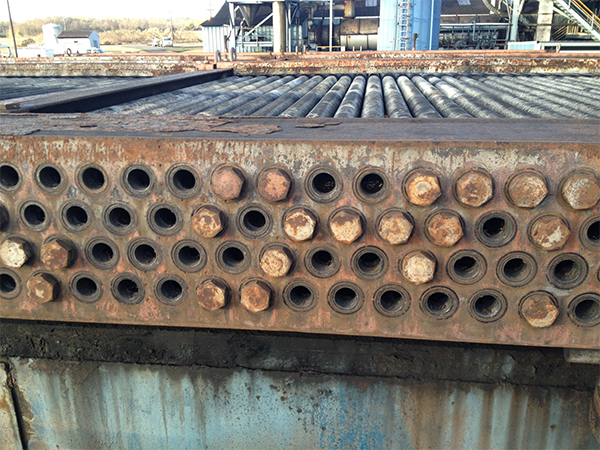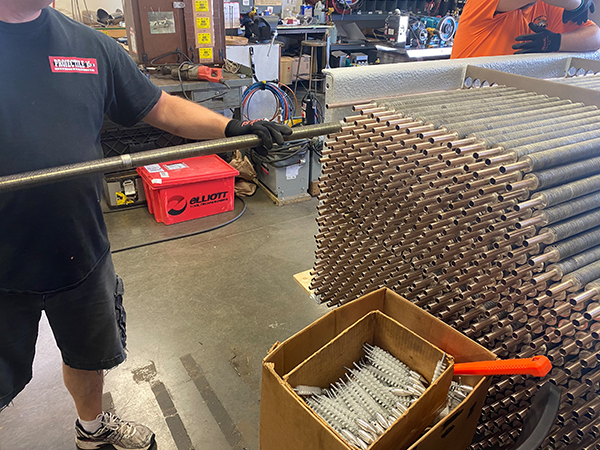Air Cooled Heat Exchanger Cleaning
Air cooled heat exchangers are frequently used in the oil, gas, refining, chemical, power and other heavy industries. Maintaining peak performance is a critical component to production at these facilities and air cooled heat exchanger cleaning is a critical part of any maintenance program. Air cooled heat exchangers have unique features that create a different set of challenges for cleaning and maintaining than traditional shell and tube heat exchangers. Air cooled heat exchanger cleaning focuses more on cleaning the air side of the heat exchanger whereas typical shell and tube exchanger maintenance is primarily done by cleaning the insides of the tubes.
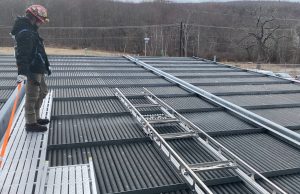
Air cooled heat exchangers are also subject to fouling on the insides of the tubes. The severity of this fouling depends on the types of liquids that run on the inside of the tubes. Cleaning the insides of the tubes on air cooled heat exchangers can be done mechanically by shooting projectiles or rotary cleaning the tubes with a cable driven mechanical device. The tubes can also be cleaned chemically or with high pressure water depending on the tube deposit circumstances. Regular maintenance to clear debris and return the tubes back to base metal will also increase efficiency of the heat transfer process, and extend the life cycle of the heat exchanger.
Air Side Cleaning Method
Traditional air cooled heat exchanger cleaning methods and systems for cleaning externally involves tedious work at dangerous heights, with scaffolds and ladders, while using fire hoses, hand lances or harsh chemicals. These methods have some considerable disadvantages such as safety hazards from doing manual work from dangerous heights, potential damage to the delicate fins of the tubing from excessive water pressures, inconsistent cleaning from using a manual method as opposed to an automated method, and the use of harsh chemicals that are harmful to the environment.
Projectile’s air cooled heat exchanger cleaning system alleviates the issues with traditional cleaning methods and creates a safe, consistent, and very effective way to clean the fin tubing of air cooled heat exchangers. Our method utilizes a compact semi-automated system that has a rail mounted series of sprayer heads that travel up and down the length of the heat exchanger to spray off debris and deposit. The system has an adjustable frame and tracks and can be adapted for use on A-frames, V-frames, vertical or flat horizontal heat exchangers with a compact size making portability easier. The semi-automated feature enables the system to be driven at an optimum speed, with the right flow rate and pressure which results in cleaning faster, more consistently, and more efficiently than hand washing, foam washers or fire hoses. Our system does not use the harsh chemicals that other companies in the industry use, immensely decreasing the environmental impact of the cleaning process and without the use of chemicals there is no risk of damaging the base tube material. Consistency of cleaning is one of the systems biggest benefits. The sprayers heads can be set at a constant distance from the tubes as well as the feed of the heads can be set at a constant rate so that all sections of the tubing will be cleaned at the same effectiveness. The sprayer head utilizes low pressure high volume water so that the cleaning of the air cooled heat exchanger will remove deposit, but it will not damage fin integrity.
Benefits to a Semi-automated Air Cooled Heat Exchanger Cleaning System:
- No personnel consistently working at dangerous heights on scaffolding or ladders
- No environmental cleanup or risk of spilling harsh chemicals
- Low pressure, high volume system that will not damage the integrity of the fins
- Consistent cleaning across the full length of the heat exchanger tubes
- Less time and cost to perform the air-cooled heat exchanger cleaning
- Minimized down time and expenses
Tube Side Cleaning of Air Cooled Heat Exchangers
Tube side deposits on air cooled heat exchangers range in type and severity depending on the liquid or gas running the tubes. There are various methods to clean the insides of the tubes depending on what type of fouling is present.
Mechanical Cleaning with Projectiles
Cleaning tubes with projectiles is typically the most efficient and best way to clean tubular heat exchangers. This method is fast, safe, and provides a good quality of cleaning. Air cooled heat exchangers can make projectile cleaning more difficult than standard shell and tube heat exchangers because typically on air cooled heat exchangers the tube sheet is recessed inside a waterbox that cannot be removed. In these cases, specially designed devices called tube bridges can be used to bridge the gap between the beginning of the header box and the tube sheet. These allow projectiles to be successfully shot to remove deposit from air cooled heat exchanger tubes.
Rotary Cleaning
Rotary cleaning is an option also offered by to clean air cooled heat exchangers. This option is usually suitable for air cooled heat exchangers because of the previously mentioned header box issue. Rotary cleaning utilizes a flexible shaft with a mechanical device on the end that spins with a water flush to remove debris from the tube wall. The flexible shaft can be easily inserted by hand through the header box and down the length of the tube on air cooled heat exchangers. Different types of cleaning tips can be used based on the type of deposit present in the tube.
Chemical Cleaning
Depending on the type of deposit in the system the air cooled heat exchanger cleaning may need to be accomplished with a chemical circulation. Typically, this is in situations where there is an extreme amount of deposit inside the tubes. Chemical cleaning is done by injecting a chemical solution designed to break down the deposit into the air cooled heat exchanger tubes and circulating the solutions for a set amount of time. After circulation the air cooled heat exchanger is flushed with water or the typical heat exchanger liquid in order to completely remove the presence of the chemical. The chemicals we use for this circulation are easily contained within the heat exchanger and then placed into storage containers for disposal. The chemicals are safe for tube materials and are biodegradable making the process completely safe.
Air Cooled Heat Exchanger Cleaning Video:
Repair and Retubing Air Cooled Heat Exchangers
Projectile is not limited to only air cooled heat exchanger cleaning services. We can also perform other maintenance and repair activities on the heat exchanger in order to maintain the unit and extend its life cycle.
Leak testing and plugging
Projectile has an array of heat exchanger tube leak testing methods to find leaks quickly and efficiently while the unit is in operation or while it is offline. In conjunction with our tube leak detection services, we also offer tube plugging services in order to fix the leaks we find. And because we manufacture the plugs, we can offer customers special discounts on our plugging services that other providers cannot.
Repair and Retubing
In certain circumstances air cooled heat exchangers may need to be completely retubed. Projectile’s retubing services can be used to completely rebuild damaged heat exchangers by removing all the tubes and installing a complete set of new tubes. This process typically is much cheaper than buying a brand new unit, but the customer has the efficiency and reliability of having a new unit after the retube is complete.
Coating
Projectile Tube Cleaning offers industrial coatings for heat exchanger tube sheets, water boxes, flanges, piping, and various other equipment that is exposed to corrosion and degradation. Heat exchanger coatings, tube sheet coatings, and coatings on related equipment can prevent future corrosion and degradation on air cooled heat exchangers.

